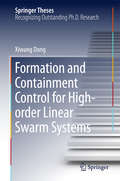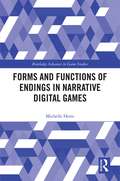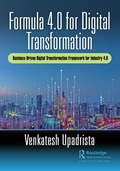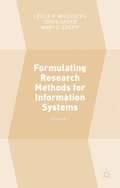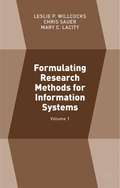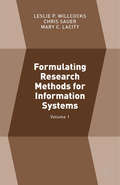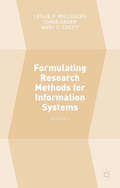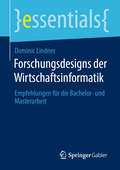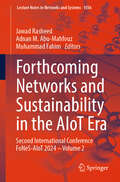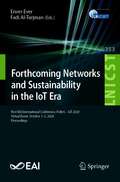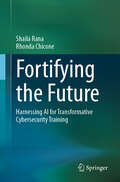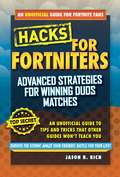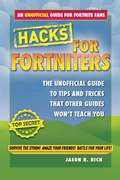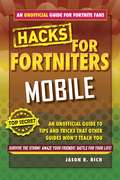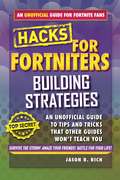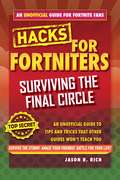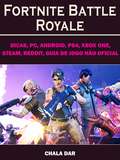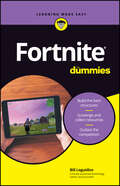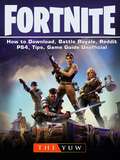- Table View
- List View
Formation and Containment Control for High-order Linear Swarm Systems
by Xiwang DongThis book focuses on analysis and design problems for high-order linear time-invariant (LTI) swarm systems (multi-agent systems) to achieve consensus, formation, containment and formation-containment. As a first step, the concepts of practical consensus and formation-containment are introduced. Unlike previous research, the formation in this book can be time-varying. A general framework for consensus, consensus tracking, formation, containment and state formation-containment is presented for the first time. Sufficient/necessary and sufficient conditions, and approaches to designing the protocols for swarm systems to achieve these control objectives, are respectively proposed. Autonomous time-varying formation experiments using five quadrotor unmanned aerial vehicles (UAVs) are conducted in an outdoor setting to demonstrate the theoretical results.
Forms and Functions of Endings in Narrative Digital Games (Routledge Advances in Game Studies)
by Michelle HerteThis book looks closely at the endings of narrative digital games, examining their ways of concluding the processes of both storytelling and play in order to gain insight into what endings are and how we identify them in different media. While narrative digital games share many representational strategies for signalling their upcoming end with more traditional narrative media – such as novels or movies – they also show many forms of endings that often radically differ from our conventional understanding of conclusion and closure. From vast game worlds that remain open for play after a story’s finale, to multiple endings that are often hailed as a means for players to create their own stories, to the potentially tragic endings of failure and "game over", digital games question the traditional singularity and finality of endings. Using a broad range of examples, this book delves deeply into these and other forms and their functions, both to reveal the closural specificities of the ludonarrative hybrid that digital games are, as well as to find the core elements that characterise endings in any medium. It examines how endings make themselves known to players and raises the question of how well-established closural conventions blend with play and a player’s effort to achieve a goal. As an interdisciplinary study that draws on game studies as much as on transmedial narratology, Forms and Functions of Endings in Narrative Digital Games is suited for scholars and students of digital games as well as for narratologists yet to become familiar with this medium.
Formula 4.0 for Digital Transformation: A Business-Driven Digital Transformation Framework for Industry 4.0
by Venkatesh UpadristaA staggering 70% of digital transformations have failed as per McKinsey. The key reason why enterprises are failing in their digital transformation journey is because there is no standard framework existing in the industry that enterprises can use to transform themselves to digital. There are several books that speak about technologies such as Cloud, Artificial Intelligence and Data Analytics in silos, but none of these provides a holistic view on how enterprises can embark on a digital transformation journey and be successful using a combination of these technologies. FORMULA 4.0 is a methodology that provides clear guidance for enterprises aspiring to transform their traditional operating model to digital. Enterprises can use this framework as a readymade guide and plan their digital transformation journey. This book is intended for all chief executives, software managers, and leaders who intend to successfully lead this digital transformation journey. An enterprise can achieve success in digital transformation only of it can create an IT Platform that will enable them to adopt any new technology seamlessly into existing IT estate; deliver new products and services to the market in shorter durations; make business decisions with IT as an enabler and utilize automation in all its major business and IT processes. Achieving these goals is what defines a digital enterprise -- Formula 4.0 is a methodology for enterprises to achieve these goals and become digital. Essentially, there is no existing framework in the market that provides a step-by-step guide to enterprises on how to embark on their successful digital transformation journey. This book enables such transformations. Overall, the Formula 4.0 is an enterprise digital transformation framework that enables organizations to become truly digital.
Formulating Research Methods for Information Systems
by Leslie P. Willcocks Mary C. Lacity Chris SauerFormulating Research Methods for Information Systems.
Formulating Research Methods for Information Systems: Volume 1
by Leslie P. Willcocks Mary C. Lacity Chris SauerFormulating Research Methods for Information Systems.
Formulating Research Methods for Information Systems: Volume 1
by Leslie P. Willcocks Mary C. Lacity Chris SauerThis edited two-volume collection presents the most interesting and compelling articles pertaining to the formulation of research methods used to study information systems from the 30-year publication history of the Journal of Information Technology .
Formulating Research Methods for Information Systems: Volume 2
by Leslie P. Willcocks Mary C. Lacity Chris SauerThis edited two-volume collection presents the most interesting and compelling articles pertaining to the formulation of research methods used to study information systems from the 30 year publication history of the Journal of Information Technology (JIT).
Forschungsdesigns der Wirtschaftsinformatik: Empfehlungen für die Bachelor- und Masterarbeit (essentials)
by Dominic LindnerIn diesem Buch werden Grundlagen zur empirischen Sozialforschung erläutert und Empfehlungen zur Findung eines Themas für die Abschlussarbeit gegeben. Anschließend werden vier Forschungsdesigns vorgestellt, ergänzt durch Tipps für die Kooperation mit einem Praxispartner. Empfehlungen zum Umgang mit Themen wie Plagiat und Zitierweise runden das Essential ab. Die Inhalte sollen Studierenden aus dem Bereich der Betriebswirtschaft und der Wirtschaftsinformatik als Hilfestellung bei der Konzeption und Erstellung einer Abschlussarbeit dienen.
Forthcoming Networks and Sustainability in the AIoT Era: Second International Conference FoNeS-AIoT 2024 - Volume 1 (Lecture Notes in Networks and Systems #1035)
by Jawad Rasheed Muhammad Fahim Adnan M. Abu-MahfouzThis book introduces a groundbreaking approach to enhancing IoT device security, providing a comprehensive overview of its applications and methodologies. Covering a wide array of topics, from crime prediction to cyberbullying detection, from facial recognition to analyzing email spam, it addresses diverse challenges in contemporary society. Aimed at researchers, practitioners, and policymakers, this book equips readers with practical tools to tackle real-world issues using advanced machine learning algorithms. Whether you're a data scientist, law enforcement officer, or urban planner, this book is a valuable resource for implementing predictive models and enhancing public safety measures. It is a comprehensive guide for implementing machine learning solutions across various domains, ensuring optimal performance and reliability. Whether you're delving into IoT security or exploring the potential of AI in urban landscapes, this book provides invaluable insights and tools to navigate the evolving landscape of technology and data science. The book provides a comprehensive overview of the challenges and solutions in contemporary cybersecurity. Through case studies and practical examples, readers gain a deeper understanding of the security concerns surrounding IoT devices and learn how to mitigate risks effectively. The book's interdisciplinary approach caters to a diverse audience, including academics, industry professionals, and government officials, who seek to address the growing cybersecurity threats in IoT environments. Key uses of this book include implementing robust security measures for IoT devices, conducting research on machine learning algorithms for attack detection, and developing policies to enhance cybersecurity in IoT ecosystems. By leveraging advanced machine learning techniques, readers can effectively detect and mitigate cyber threats, ensuring the integrity and reliability of IoT systems. Overall, this book is a valuable resource for anyone involved in designing, implementing, or regulating IoT devices and systems.
Forthcoming Networks and Sustainability in the AIoT Era: Second International Conference FoNeS-AIoT 2024 - Volume 2 (Lecture Notes in Networks and Systems #1036)
by Jawad Rasheed Muhammad Fahim Adnan M. Abu-MahfouzThis book introduces a groundbreaking approach to enhancing IoT device security, providing a comprehensive overview of its applications and methodologies. Covering a wide array of topics, from crime prediction to cyberbullying detection, from facial recognition to analyzing email spam, it addresses diverse challenges in contemporary society. Aimed at researchers, practitioners, and policymakers, this book equips readers with practical tools to tackle real-world issues using advanced machine learning algorithms. Whether you're a data scientist, law enforcement officer, or urban planner, this book is a valuable resource for implementing predictive models and enhancing public safety measures. It is a comprehensive guide for implementing machine learning solutions across various domains, ensuring optimal performance and reliability. Whether you're delving into IoT security or exploring the potential of AI in urban landscapes, this book provides invaluable insights and tools to navigate the evolving landscape of technology and data science. The book provides a comprehensive overview of the challenges and solutions in contemporary cybersecurity. Through case studies and practical examples, readers gain a deeper understanding of the security concerns surrounding IoT devices and learn how to mitigate risks effectively. The book's interdisciplinary approach caters to a diverse audience, including academics, industry professionals, and government officials, who seek to address the growing cybersecurity threats in IoT environments. Key uses of this book include implementing robust security measures for IoT devices, conducting research on machine learning algorithms for attack detection, and developing policies to enhance cybersecurity in IoT ecosystems. By leveraging advanced machine learning techniques, readers can effectively detect and mitigate cyber threats, ensuring the integrity and reliability of IoT systems. Overall, this book is a valuable resource for anyone involved in designing, implementing, or regulating IoT devices and systems.
Forthcoming Networks and Sustainability in the IoT Era: First EAI International Conference, FoNeS – IoT 2020, Virtual Event, October 1-2, 2020, Proceedings (Lecture Notes of the Institute for Computer Sciences, Social Informatics and Telecommunications Engineering #353)
by Fadi Al-Turjman Enver EverThis proceedings constitutes the refereed proceedings of the First EAI International Conference on Forthcoming Networks and Sustainability in the IoT Era, FoNeS 2020, held in October 2020. Due to COVID-19 pandemic the conference was held virtually. The 13 papers presented were carefully selected from 28 submissions. The papers focus application areas for advanced communication systems and development of new services, in an attempt to facilitate the tremendous growth of new devices and smart things that need to be connected to the Internet through a variety of wireless technologies. The papers are organized in topical sections on IoT and network applications; machine learning and distributed computing; and cellular networks and security.
Fortifying the Future: Harnessing AI for Transformative Cybersecurity Training
by Shaila Rana Rhonda ChiconeThis comprehensive handbook explores how artificial intelligence is transforming cybersecurity training, with a specific focus on practical implementation strategies for organizations. The book examines AI-driven approaches including personalized learning systems, gamification techniques, and immersive training environments using virtual and augmented reality. It provides detailed guidance on creating adaptive learning programs that respond to individual learner needs while addressing emerging cybersecurity threats. Key topics include AI-powered personalization of training content, development of realistic threat scenarios, integration of VR/AR technologies for hands-on practice, and implementation of gamification elements to boost engagement. The book offers concrete strategies for organizations to leverage AI in building more effective and engaging cybersecurity training programs that adapt to evolving security challenges. This handbook distinguishes itself from existing cybersecurity literature by focusing specifically on AI's application in training and skill development, rather than general cybersecurity operations. It serves both as a practical guide for professionals implementing AI-driven training programs and as a valuable resource for researchers and educators in cybersecurity, artificial intelligence, and organizational learning.
Fortnite - O Guia Completo Para Iniciantes (1 #1)
by Samson Oloruntobi André Luiz Franco de Souza FilhoAprenda as melhores dicas secretas que nunca lhe contaram que vão ajudar você a ganhar todas às vezes no Fortnite Battle Royale. Fortnite está lentamente tomando o mundo, e o jogo se torna mais difícil de ganhar à medida que as temporadas passam. Dicas de alguns meses atrás não são mais úteis porque o Meta mudou para novas táticas. Você vai encontrar melhores inimigos, especialmente se você estiver jogando em uma área com bastantes jogadores. Esse guia, que é o mais completo, é recheado de segredos que você nunca escutou acerca do Fortnite. Você vai aprender todas as dicas e truques que farão de você um profissional no jogo. Essas dicas vão ajudar você a conseguir várias vitórias e ainda vai poder mostrar todas as suas novas habilidades para os seus amigos. Se você joga Fortnite há um tempo e acha que não é bom o suficiente para ganhar, então esse livro é para você. Ele vai fazer você melhorar em todos os sentidos e você vai facilmente conseguir sua primeira vitória, se você ainda não tem. Aqui, nós temos mais de 100 dicas que são perfeitas para iniciantes e jogadores intermediários, e esperamos, para os Profissionais do Fortnite Battle Royale também. E se você acha que sabe tudo de Fortnite, o que você provavelmente sabe mesmo, esse guia vai te dar algo que você não sabe.
Fortnite Battle Royale Hacks: Advanced Strategies for Winning Duos Matches (Fortnite Battle Royale Hacks)
by Jason R. RichFortnite had than 10 million players 2 weeks after its release in September of 2017 and now has more than 40 million players worldwide. The game has 1.2 million likes on Facebook, 1.3 million followers on Instagram, and 1.74 million followers on Twitter.
Fortnite Battle Royale Hacks: An Unoffical Guide to Tips and Tricks That Other Guides Won't Teach You (Fortnite Battle Royale Hacks #1)
by Jason R. RichOver 270 screenshots with expert instructions! The ultimate Fortnite strategy guide with the tips and tricks you need!The best Fortnite book for kids eight and up, this full-color, unofficial strategy guide is a comprehensive guide to Fortnite: Battle Royale. This Fortnite guide book focuses heavily on what to expect throughout the island. Important locations on the Fortnite island are referred to as points of interest. Regardless of your experience or skill level playing the Fortnite: Battle Royale game, or which gaming platform you’re playing on, you’ll discover how the terrain dramatically varies based on where you are on the map. In addition to learning essential information about each point of interest, in this Fortnite Battle Royale book, you’ll learn:Proven tips and strategies for location-specific fightingHow and where to collect weapons, ammo, items, and lootHow and why you need to gather resources (wood, stone, and metal)How to build structures, ramps, bridges, and fortressesHow to safely explore and travel between points of interest on the islandHow to safely navigate around based on the location of the deadly storm - which makes an ever-growing portion of the island uninhabitable as each battle progresses Fortnite Battle Royale Hacks: Secrets of the Island is the complete Fortnite Battle Royale cheat book that showcases each point of interest using text and screenshots, so you can become intimately familiar with the important locations you’ll be visiting during the action-packed battles in the game. Fortnite Battle Royale Hacks: Secrets of the Island takes a geography-based approach to helping you become victorious, while also providing essential fighting, building, and exploring strategies that will prove extremely valuable during each battle. Because this Fortnite: Battle Royale tips book never offers the same play experience twice (since how the action unfolds depends heavily on the actions of the other 99 human players also on the island), this unofficial guide will teach you to adapt your offensive and defensive fighting strategies as needed to dramatically increase your chance of survival during each and every action-packed battle, regardless of where on the island a battle is taking place.
Fortnite Battle Royale Hacks: An Unoffical Guide to Tips and Tricks That Other Guides Won't Teach You (Fortnite Battle Royale Hacks #1)
by Jason R. RichThe Premier Fortnite Advanced Strategy Guide Book for the Most Popular Game in the World!The explosive, up-to-date Fortnite Battle Royale tips book for experienced players, this advanced Fortnite cheat book is the ultimate Fortnite book for kids and adults age 8 and up. Fortnite Battle Royale Hacks: Advanced Strategies focuses on more advanced game play strategies. This Fortnite strategy guide book for advanced Fortnite gamers will teach you: Advanced Fortnite strategies related to where to land on the Fortnite island to quickly find weapons and ammo! In-depth strategies for surviving the final circle, when the inhabitable map is very small and only a small handful of adversaries remain! The best uses for the individual Fortnite weapons in the Fortnite game! How to customize your Fortnite character’s appearance! How to customize your controls to achieve the best accuracy and speed in battles!If you manage to survive until the final circle, you need a new collection of Fortnite Battle Royale strategies. Fortnite Battle Royale Hacks: Advanced Strategies is the Fortnite strategy book that will help more experienced Fortnite game players like you prepare to reach the final circle, and then give you the expert Fortnite tips and tricks you need to become the last soldier standing at the end of each battle. For example, with this Fortnite Battle Royale book, you’ll learn how to quickly design and build an extremely tall and secure fortress.Fortnite Battle Royale Hacks: Advanced Strategies is the unauthorized guide book that will teach you how to advance on the final Fortnite enemies and defend against their attacks as they push toward your fortress for a final assault. This Fortnite guide book will also explain how to become a Fortnite pro and master the newest Fortnite gameplay modes that allow you to group with other players into pairs or teams of four in order to defeat all adversaries on the island.There is no second place in Fortnite!
Fortnite Battle Royale Hacks: An Unofficial Guide to Tips and Tricks That Other Guides Won't Teach You (Fortnite Battle Royale Hacks #1)
by Jason R. RichThe Ultimate Fortnite Guide… There is no second place!Fortnite Battle Royale Hacks is the Fortnite strategy book you’ve been waiting for! This Fortnite Battle Royale book focuses on the seven core elements of gameplay, giving you the TOP SECRET know-how to turn you into a Fortnite pro. This Fortnite strategy guide includes: Character Section, Customization, and Improvement Parachuting from the Battle Bus and Choosing an Ideal Landing Location Safe Exploration of the Island and Avoiding the Storm Finding and Gathering the Best Weapons, Ammo, and Loot Acquiring Resources (Wood, Brick, and Metal) Building Fortresses and Structures Surviving Combat to Become the Last Person StandingFor Playstation 4, Xbox One, Windows PC, and Mac, the Fortnite game transports gamers to an island that’s in the direct path of a strange and deadly storm. This free edition is a quest for survival?as one hundred players get trapped on the island, but only one will ultimately survive!Fortnite players must explore their surroundings to gather resources and then build protective shelters, plus locate weapons and loot (medical packs, potions, ammo, etc.)?all while attempting to defeat enemies in battle as the storm approaches, slowly making more and more of the island inhabitable. With so much at stake, you need the most up-to-date, comprehensive Fortnite book there is.This unofficial Fortnite Battle Royale strategy guide book for gamers ages 8 and up provides the tips and information needed to greatly improve your chances for survival. Fortnite Battle Royale Hacks is the ultimate unauthorized guide book that includes proven strategies for defeating opponents using weapons, tools, resources, and structures.Because the Fortnite Battle Royale game never offers the same play experience twice, this Fortnite Battle Royale tips book teaches you to adapt your offensive and defensive fighting strategies as needed to dramatically increase your chance of survival during each and every action-packed battle.This full-color, information-packed, 98-page Fortnite Battle Royale book for kids, teens, and adults is expertly designed to help first-time players greatly shorten the game’s learning curve and allows readers to abandon their “noob” status quickly, while dramatically improving their fighting, building, exploration, and survival skills. Experienced players will get an edge over their competitors with this legendary guide! With limited training activities and tutorials built into the game, Fortnite Battle Royale Hacks is the MUST READ game guide for beginner, intermediate, and advanced players… This is THE Fortnite cheat book for all the tips and tricks you won’t learn anywhere else.
Fortnite Battle Royale Hacks: An Unofficial Guide to Tips and Tricks That Other Guides Won't Teach You (Fortnite Battle Royale Hacks)
by Jason R. RichFortnite: Battle Royale Hacks: Mobileoffers a comprehensive introduction to playing this massively multiplayer, online-based game while on-the-go from a smartphone or tablet. For example, it focuses on customizing the game controls using the Customizable HUD (Head-Up Display) interface and discuss the pros and cons of using a Cellular Data Connection versus a Wi-Fi Internet connection when playing. Each section of this unofficial strategy guide covers a different aspect of the game play experience. The book contains hundreds of full-color screenshots taken using an iPhone and iPad, and potentially Android-based devices as well. Targeted to readers age 8 and up, Fortnite: Battle Royale Hacks for Mobile will be a full-color, unofficial strategy guide that will focus on: The intricacies of playing Fortnite: Battle Royale on a smartphone or tablet. How to download and install the game and set up an Epic Games account to start playing for free. How to customize the on-screen controls using the Customizable HUD that’s exclusive to the mobile version of the game. How to customize a character’s appearance. Getting acquainted with the game play modes. Tips and strategies for choosing the ideal landing location; exploration; building; gathering resources; finding and collecting loot; managing a character’s inventory; finding, choosing and using weapons; perfecting weapon aim; avoiding the storm; and winning matches. Because Fortnite: Battle Royale never offers the same play experience twice (since how the action unfolds depends heavily on the actions of the other 99 human players also on the island), this unofficial guide will teach players to adapt their offensive and defensive fighting strategies as needed to dramatically increase their chance of survival during each and every action-packed battle, regardless of where on the island a battle is taking place.
Fortnite Battle Royale Hacks: An Unofficial Guide to Tips and Tricks That Other Guides Won't Teach You (Fortnite Battle Royale Hacks)
by Jason R. RichFortnite Battle Royale Hacks: Building Strategies will demonstrate how to build a variety of customized structures, as well as offer fortress design ideas utilized by pro players. Step-by-step building instructions, along with full-color screenshots and strategies for choosing the right building materials and building locations, are provided within this invaluable resource. In addition to these building strategies, this full-color, unofficial strategy guide will also provide hundreds of tips and tricks for surviving and winning each match. To survive, a player must simultaneously handle several key tasks, including: Exploration of the Island Finding, Collecting, and Using Weapons Finding, Collecting, and Using Loot Items Gathering and Using Resources Engage in Combat Against Enemy Soldiers Avoid the Deadly Storm Building Structures and Fortresses Targeted to readers age 8 and up, this unofficial guide will provide a comprehensive overview of the Fortnite Battle Royale game, regardless of which gaming platform the reader is using. An emphasis, however, will be placed on teaching expert building strategies that can be used throughout each match. An entire section of the book will include End Game fortress building strategies that will appeal to beginner and expert players alike.
Fortnite Battle Royale Hacks: An Unofficial Guide to Tips and Tricks That Other Guides Won't Teach You (Fortnite Battle Royale Hacks)
by Jason R. RichIn addition to the Solo game play mode (which pits each gamer up against up to 99 others in a real-time battle), the Duos mode allows gamers to team up with one friend in a quest to defeat all other gamers during a match. Meanwhile, the Squads mode allows teams of four players to enter into a match and work together as they battle against up to 96 other gamers. The Duos and Squads game play modes are permanent features built into the game, and they’ve proven to be extremely popular, since Fortnite: Battle Royale is, for the most part, cross-platform compatible. Thus, someone experiencing the game on a PS4 can team up with a PC user, for example, to play against a random section of other gamers, in real-time. An Encyclopedia of Strategies for Fortniters: Duos and Squads Strategies will be the first book in this unofficial strategy guide series to offer in-depth coverage of Fortnite: Battle Royale’s team-oriented game play modes. Thus, this unofficial strategy guide will be chock full of proven strategies and game play tips designed to help teams achieve victory in the Fortnite: Battle Royale matches they participate in. This expanded (approximately 176-page) guide will include a comprehensive overview of the Fortnite: Battle Royale game, with a special focus on the game’s team-oriented game play modes. The full-color book will appeal to readers age 8 and up, regardless of which gaming platform they’re using. Throughout each match, gamers must: Focus on survival Avoid the deadly storm Explore the island Gather resources Build structures and fortresses Find, collect, and utilize weapons and ammunition Acquire and use loot items Engage in combat against enemy soldiers with the goal of becoming the last person alive at the end of the match When experiencing any of the team-oriented game play modes, cooperative gameplay (teamwork) and communication with team members become vital. An Encyclopedia of Duos and Squads Strategies will soon be an indispensable resource for gamers experiencing the Duos or Squads game play modes (or any of the other team-oriented game play modes added to Fortnite: Battle Royale on a temporary basis).
Fortnite Battle Royale, Dicas, PC, Android, PS4, Xbox One, Steam, Reddit, Guia de Jogo não Oficial
by The YuwQueres dominar o jogo e os teus oponentes? Tens dificuldades em recolher recursos? Queres os melhores itens? Queres saber como transferir e instalar o jogo? Se sim, então estamos aqui para ti. Vamos guiar-te pelo jogo, partilhar os truques e estratégias dos profissionais, e contar-te os segredos do jogo. O que vais encontrar neste livro: - Como transferir e instalar o jogo. - Dicas e estratégias dos profissionais. - Truques. - Zonas de Aterragem. - Armas. - Trackers. - Como ganhar um combate! - Como Dominar o Multiplayer! - Combate e Movimento. - Construções. - Segredos, Dicas, Truques, Unlockables, e os Truques usados pelos Pros! - Como apanhar montes de recursos. - E MUITO MAIS! Então, de que estás á espera? Assim que agarrares uma cópia do nosso guia vais começar a dominar o jogo em menos de nada! Agarra já as tuas pro tips.
Fortnite Battle Royale: los Chistes y Memes más Divertidos y Épicos
by Joke Factory¡Consigue acceso directo a los memes más divertidos de Fortnite! Descubrirás los mejores memes de Fortnite. En este libro encontrarás algunos de los mejores memes de Fortnite. ¡Descubre el juego más popular de Epic Games a través de los chistes y memes más tontos, ridículos y, simplemente, más divertidos! ¡Descarga tu ejemplar fácilmente! ¡Hazte con él y descubre los memes más populares de Fortnite!
Fortnite Come scaricare, Battle Royale, Reddit, PS4, Suggerimenti, Guida di Gioco Non Ufficiale
by The Yuw* GUIDA NON UFFICIALE * Vuoi dominare il gioco e i tuoi avversari? Hai difficoltà ad ottenere risorse e denaro? Vuoi i pezzi migliori? Ti piacerebbe sapere come scaricare ed installare il gioco? Se è così, ti aiutiamo noi. Ti guideremo attraverso il gioco, ti forniremo strategie e suggerimenti professionali, oltre a tutti i segreti del gioco. Cosa troverai all'interno: - Come scaricare e installare il gioco - Suggerimenti e strategie professionali - Trucchi e dritte - Zone di atterraggio - Armi - Localizzatori - Batti gli avversari! - Dominare il multiplayer! - Combattimento e movimento. - Costruzioni - Segreti, suggerimenti, trucchi e sblocchi utilizzati da giocatori professionisti! - Come ottenere tonnellate di risorse - MOLTO ALTRO Allora, cosa stai aspettando? Una volta acquistata una copia della nostra guida dominerai il gioco in men che non si dica! Prenditi i tuoi Suggerimenti Pro Adesso! --> Scorrere fino alla parte superiore della pagina e fare clic su Aggiungi al carrello per acquistarlo immediatamente Disclaimer: Questo prodotto non è associato, affiliato, approvato, certificato o sponsorizzato dal proprietario del copyright originale.
Fortnite For Dummies
by Bill LoguidicePlay—and survive—in the game of Fortnite! Zombies. Battle. Survival. Fortnite has it all—and if you want to keep your gameplay going until the bitter end to outlast your competition, this book is the ace in your back pocket! Choose a gaming platform Download and optimize the game Play in each of the gameplay modes Scavenge, loot, and collect resources Avoid death and outlast your opponents Who will be the last person standing? When you want to outlast the competition and make Fortnite yours, this book makes it easier than ever to come out on top.
Fortnite-How to Download, Battle Royale, Reddit, PS4, Tips, Unofficial Game Guide.: A Step-by-Step Guide on How to Download and Perfect Your Performance in Fortnite
by The YuwUNOFFICIAL GUIDE Do you want to dominate the game and beat your opponents? Do you find it difficult to collect resources and get the necessary money? Want the best items? Would you like to know how to download and install the game? If so, we've got you covered. We will guide you through the game, giving you tips and explaining strategies from professionals, as well as all the secrets of the game. In this guide, you'll discover: How to download and install the game. Professional tips and strategies. Tricks and shortcuts. Landing zones. Weapons. Trackers. How to defeat opponents! Master multiplayer. Combat and movements. Constructions. Secrets, tips, shortcuts, unlockables, and cheats used by the best players. How to get lots of resources. AND MUCH MORE! So what are you waiting for? Once you pick up and read a copy of this guide, you'll be mastering the game in no time! Get your professional advice now!
